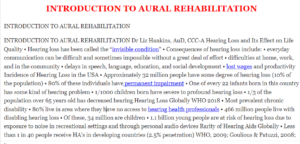INTRODUCTION TO AURAL REHABILITATION
INTRODUCTION TO AURAL REHABILITATION
INTRODUCTION TO AURAL REHABILITATION
INTRODUCTION TO AURAL REHABILITATION Dr Liz Hankins, AuD, CCC-A Hearing Loss and Its Effect on Life Quality • Hearing loss has been called the “invisible condition” • Consequences of hearing loss include: • everyday communication can be difficult and sometimes impossible without a great deal of effort • difficulties at home, work, and in the community • delays in speech, language, education, and social development • lost wages and productivity Incidence of Hearing Loss in the USA • Approximately 32 million people have some degree of hearing loss (10% of the population) • 80% of these individuals have permanent impairment • One of every 22 infants born in this country has some kind of hearing problem • 1/1000 children born have severe to profound hearing loss • 1/3 of the population over 65 years old has decreased hearing Hearing Loss Globally WHO 2018 • Most prevalent chronic disability
• 80% live in area where they have no access to hearing health professionals • 466 million people live with disabling hearing loss • Of these, 34 million are children • 1.1 billion young people are at risk of hearing loss due to exposure to noise in recreational settings and through personal audio devices Rarity of Hearing Aids Globally • Less than 1 in 40 people receive HA’s in developing countries (2.5% penetration) WHO, 2009; Goulious & Patuzzi, 2008; Fagan & Jacobs, 2009, Swamepoel, 2010 Ratio of Audiologists to People Developed: 1:20,000 Developing: 0.5-.625m Africa: 1 million WHO, 2009; Goulious & Patuzzi, 2008; Fagan & Jacobs, 2009, Swamepoel, 2010 • Influences of Hearing Loss in the United States • Family Income: more people with severe HL earn less than 15,000/year than people with no hearing loss • Employment Status: more unemployed, less promotions, less satisfaction with employment • Education: as degree of hearing loss increases, level of education decreases • Marital status and living arrangements: more divorced and live alone • Births: less births (probably related to above stat) Aural Rehabilitation • Simply defined, aural rehab is any effort aimed at minimizing and/or alleviating the effects of hearing loss on communication • know the difference between rehabilitation and habilitation • AR includes: • providing technical support • working with the individual to maximize the use of their residual hearing • counseling to help the person cope with the effects of having a hearing loss Who Provides Aural Rehab? • Not just the audiologist • Audiologists • Speech Language Pathologists • Teachers for the hard-of-hearing or deaf • sometimes even the resource teacher or school support • In many cases of aural rehab, the SLP fills the auditory training and speechreading training History of Aural Rehabilitation • Ponce de Leon of Spain is one of the first identified teachers of the deaf • Periere introduced education of the deaf to France in the 1700’s • Thomas Braidwood in England and Samuel Heinicke in Germany began education for the deaf focused on teaching speech reading and speaking in the 1700’s • Thomas Gallaudet eventually began the first successful school for the deaf in America based on teaching from Laurent Clerc History of Aural Rehab (continued) • Horace Mann and Alexander Graham Bell first championed the oral method of deaf education in the mid 1800’s • World War II brought about the need and development of the profession of audiology which was essentially a profession for people wanting to practice aural rehabilitation • Audiology has gotten away from its roots to the point that less than half of all audiologists now do not provide much aural rehabilitation beyond that directly associated with hearing aid sales Hearing Loss as Described in Aural Rehab • In audiometric terms, we describe a hearing loss in terms of its degree, nature and configuration • In aural rehabilitation terms, we describe a hearing loss in terms of its degree, onset, and progression • i.e. prelingual, postlingual, sudden hearing loss, progressive hearing loss, congenital hearing loss, adventitious hearing loss, etc… A Review of the Guidelines for Audiogram Interpretation • Look at each ear separately • Describe • degree of hearing loss • nature of hearing loss • audiometric configuration Degree of Hearing Loss Nature of Hearing Loss • Based on presence or absence of an air-bone gap • Conductive= The cochlea hears fine (resulting in normal bone conduction [BC] hearing) but there is a loss that is due to a problem of the outer or middle ear resulting in reduced air conduction [AC] thresholds • Sensorineural= BC agrees with AC and both show a hearing loss – the problem is in the cochlea or along the neural pathway • Mixed= BC shows loss and AC also shows loss even greater than BC – there is a problem in both the cochlea and in the conductive system Audiogram Configurations • Based on AIR CONDUCTION thresholds • Flat (AC thresholds within 10 dB) • Gradually sloping • Steeply sloping or markedly sloping • Rising • Ski-slope or precipitously sloping • Cookie bite or trough • Reverse cookie bite Audiogram Configurations (Continued) • Jagged (W Shaped) • Peaked • Fragmentary or Corner • Notched Terminology • Deaf or deafness definitions • social – everyday auditory/verbal communication is impossible or nearly so • medico-legal – The average threshold at 500, 1000, and 2000 Hz is over 90 dB HL • educational – if the primary mode of learning is not auditory, he/ she is considered deaf • cultural – written with a capital “D”, people who communicate using ASL and consider themselves as a minority group and not as handicapped individuals More Definitions • Hard of hearing – a person with hearing loss but who is not “deaf” by any of the previously discussed definitions • Peripheral hearing loss – hearing loss that occurs up to the level of the cochlea • Central hearing loss – hearing loss that occurs from the VIII cranial nerve and up to the cortex • Organic hearing loss – hearing loss that has an anatomical, physiological, or metabolic etiology • Functional hearing loss – hearing loss where the organic etiology is unknown More Definitions • Percentage of hearing loss – This term is reserved for medico-legal use. • Percentage of hearing loss is calculated using a formula which varies from state to state. Audiologists do not like to use percentage of loss to characterize hearing loss because it misleads people to think that any two people with similar hearing loss will have the same amount of difficulty – not true!
Use the following coupon code :
NursesHomework


